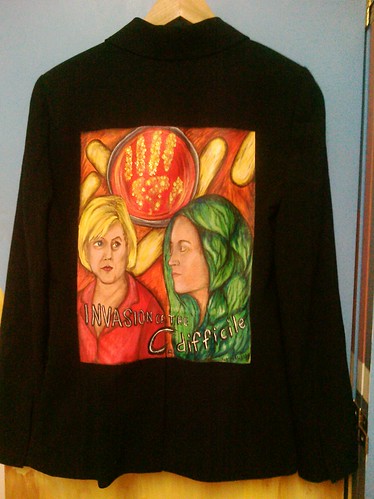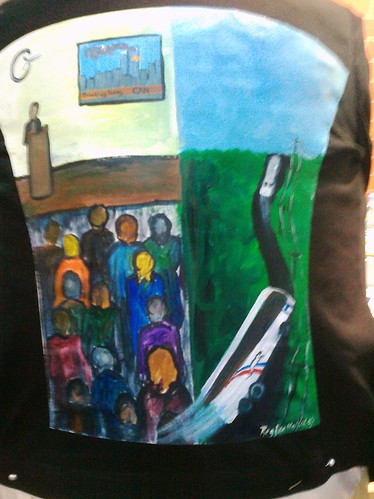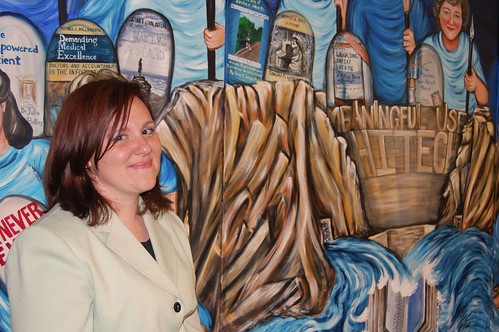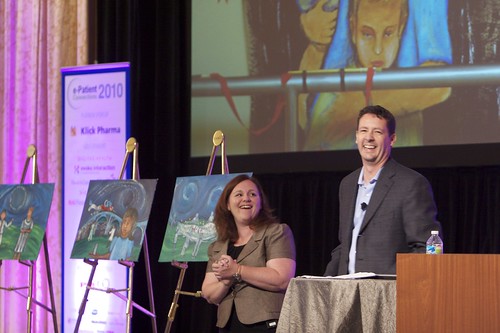Though The Walking Gallery is Walking Around the World, based on current information we have no one walking in 20 states in the
US. I say let’s change that! So if you know folks who should join us in the states listed below, please let me know.
There are currently 28 jacket in my to-do pile and hopefully some of them will be from states that do not have walkers, but if you know of excellent walkers or potential gallery artists please send them my way!
Also we only have walkers in 7 countries right now; I bet we can improve on that.
Thank you to the
Walking Gallery on Medstartr, that money funded patient attendees to The Walking Gallery gathering in Kansas City and supported continued spread of this worthy advocacy!
The artists of the gallery:
1. Regina Holliday 198 jackets
2. Isaac Holliday 6 yrs, 1 jacket
3. Becca Price, 1 jacket
4. Miriam Cutelis, 1 jacket
5. Ess Lipczenko, 1 jacket
6. Ben Merrion 1 jacket
7. Courtney Mazza 4 jackets
8. Michele Banks 1 jacket
9. Megan Mitchell 15 yrs 1 jacket
10. Robert J. Filley 3 jackets
11. Anita Samarth 1 jacket
12. Mary Welch Higgins 2 jackets
13. Richard Sachs 1 jacket
14. Jonah Daniel 5yrs 1 jacket
15. Fred Trotter 1 jacket
16. Leela 7yrs 1 jacket
17. Gayle Schrier Smith, 1 Jacket
![DC Health Week HealthCamp - Walking Gallery 13160]()
Australia
Heather Leslie, Melbourne
Louise Schaper, Melbourne
Sam Bruinewoud, Melbourne
Carolyn Der Vartanian, Sydney, NSW
Michelle F Davis, Sydney, NSW
Lissa Smith, Sydney, NSW
Sanya Turalj, Sydney, NSW
Kath Mazella, Perth
![Louise Schaper]()
Canada
Collin Hung, Toronto
Colleen Young, Winnipeg
Carolyn Thomas, Victoria, BC
Natrice Rese, Timmins, Ontario
Greece
Kathi Apostolidis
France
Gangadhar Sulkunte
Senegal
Kevin Ado
United Kingdom
Andrew Spong, Rustington, West Sussex
United States of America: Districts/Commonwealths and Territories
1. Alabama
2. Alaska
3. Arizona
4. Arkansas
5. California
Al Nikolai Kirienko- Berkley
Jamie Inman, Hollister
Alan Greene, San Francisco
Matthew Holt, San Francisco
Katherine Arbansin, San Francisco
Karen Herzog, San Francisco
Manny Hernandez, San Francisco
Danielle Cass, San Francisco
Roni Zeiger, San Francisco
Amy Tenderich, SanFrancisco
Julia Hallisy, San Francisco
Alex Albin, Monterey
Christian Liu, Los Angeles
Liza Bernstein, Los Angelos
Matthew Listiak, Los Angeles
Martine Ehrenclou, Los Angeles
Gregg Masters, San Diego
Katerina Jackson-Suchkova, San Diego
Becca Price, San Diego
Charles Denham, Palo Alto
Larry Chu, Palo Alto
Kristen Andrews, Monrovia
Amanda Greene, Culver City
Jan Oldenburg,
6. Colorado
Kathy Nicholls, Pueblo
Ben Miller, Denver
Erika Hanson Brown, Denver
Bart Windrum, Boulder
7. Connecticut
Matthew Browning
8. Delaware
9. ![#hcdc I'm in there somewhere #epicenter]()
District of Columbia/Greater Washington Area Valarie Barnes
Ann Bartlett
Karen E. Blair
Siobhan Champ-Blackwell
Jodi Daniel
Jonah Daniel
Ladd Everitt
Lisa Emrich
Ted Eytan
Robert Filey
Susannah Fox
Marsha Goodman-Wood
David Hale
Mary Welch Higgins
Isaac Holliday
Freddie Holliday
Regina Holliday
Linsey Hoggle
Alisa Hughley
Karen Hwang
Jess Jacobs
Leroy Jones
Nicole Kemper
Morgan Stanley-Kominers
Christine Kraft
Marilyn Langfeld
Howard Liebers
Kym Martin
Ross Martin
Courtney Mazza
Deven McGraw
Jake Miles-McLean
Robin Miles-Mclean
Ben Merrion
Megan Mitchell
Farzad Mostashari
John O’Brien
Todd Park
Elizabeth Prevou
Abigail Pritchard
Anita Samarth
Josh Seidman
Emily Stewart
Mary Anne Sterling
Marie-Michelle Strah
Lygeia Ricciardi
Leela
Liz Sherer
Chris Timm
Teresa Titus-Howard
Cindy Throop
Carol Torgan
Melinda Whatman
Claudia Williams
Trenor Williams
Eunita Winkey
William Wolf
Whitney Zatzkin
![DC Health Week HealthCamp - Walking Gallery 13297]()
10. Florida
Chiara Bell, Orlando
Carolyn Capern, Orlando
11. Georgia
Donna Scott, Atlanta
12. Hawaii
13. Idaho
14. Illinois
Michael Millenson, Chicago
Karen Curtiss, Chicago
Amanda Michelle Jones, Chicago
JoAnn Klinedinst, Chicago
15. Indiana
Michele Behme, Indianapolis
16. Iowa
17. Kansas
Ryan Neuhofel, Lawrence
Jari Holland Buck, Overland Park
18. Kentucky
Ted Smith, Louisville
19. Louisiana
Catherine Fairchild, Baton Rouge
20. Maine
Andrea Littlefield, Bangor
21. Maryland
Maumi JC Chatterton, Baltimore
Mark Scrimshire, Baltimore
Dennis Wagner, Baltimore
Peter Levin, Silver SPring
Kait B. Roe, Baltimore
22. Massachusetts
Keith Boone, Boston
Abigail Boone, Boston
Alex Drane, Boston
Nate Osit, Boston
Janice McCallum, Boston
David Harlow, Boston
John Kruger, Boston
Don Fluckinger, Boston
Alicia Staley, Boston
Karen MacDonald, Boston
![David and Regina]() 23. Michigan
23. Michigan
24. Minnesota
Gary Oftedahl, Minneapolis
Gail Zahtz, Minneappolis
Victor Montori, Rochester
Steven Baker, Fountain
25. Mississippi
26. Missouri
Joe Ketcherside: Kansas City
Tobias Gilk, Kansas City
David Sides, Kansas City
Clay Patterson, Kansas City
Kourtney Govro, Kansas City
Ann Becker-Schutte, Kansas City
Brian Carter, Kansas City
27. Montana
28. Nebraska
29. Nevada
Jen McCabe, Las Vegas
30. New Hampshire
Dave deBronkart
31. New Jersey
Ileana Balcu, Woodbridge
John Phelan, Princeton
Mindy Schwartz-Brown
32. New Mexico
33. New York
Trisha Torrey, Baldwinsville
Steven Davidson, Brooklyn
Wen Dombrowski, NY
Tiffany Petterson, NY
Jason Bhan, NY
Craig Lipset,NY
Alex Fair, NY
Paulo Machado, NY
Amy Romano, NY
Dale Ann Micalizzi, Schenectady
Emily Hackel, NY
Esther Dyson, NY
34. North Carolina
Richard Payne, Durham
Lisa Fields, Greensborro
Sarah E. Kucharski, Canton
Liza Sisler, Raleigh-Durham
Andre Blackman, Raleigh-Durham
Alice Hughley, Durham
35. North Dakota
36. Ohio
Sunnie Southern, Cincinnati
Michael Seid, Cincinnati
37. Oklahoma
38. Oregon
Lizzie Dunklee, Eugene
Amy Birney, Eugene
Brian Ahier, Portland
Sue Woods, Portland
39. Pennsylvania
David Lee Scher, Harrisburg
Jenny Pettit, Philadelphia
Jane Sarasohn-Kahn, Philadelphia
Mary Ellen Mannix
Koreen Olbrish, Philadelphia
Teresa Younkin, Scranton
Kate Cartwright-Knodel, Yardley
40. Puerto Rico
Antonio Fernandez
41. Rhode Island
Pat Mastors, Providence
42. South Carolina
Helen Haskell, Columbia
43. South Dakota
44. Tennessee
Linda Stotsky, Nashville
45. Texas
Fred Trotter, Houston
Joleen Chambers, Dallas
Laura Slayton, Austin
Erin Gilmer, Austin
46. Utah
Michelle Litchman, Salt lake City
47. Vermont
48. Virginia
Josh Rubin, Arlington
Casey Quinlan-Richmond
David Collins, Richmond
Richard Upton, Richmond
Angela Lynn- Charlottesville
Heidi Sitcov, Springfield
Gayle Schrier Smith, Richmond
49. Washington
Wendy Sue Swanson, Seattle
Sherry Reynolds, Seattle
Leah Marcotte, Seattle
50. West Virginia
51. Wisconsin
52. Wyoming


















































































